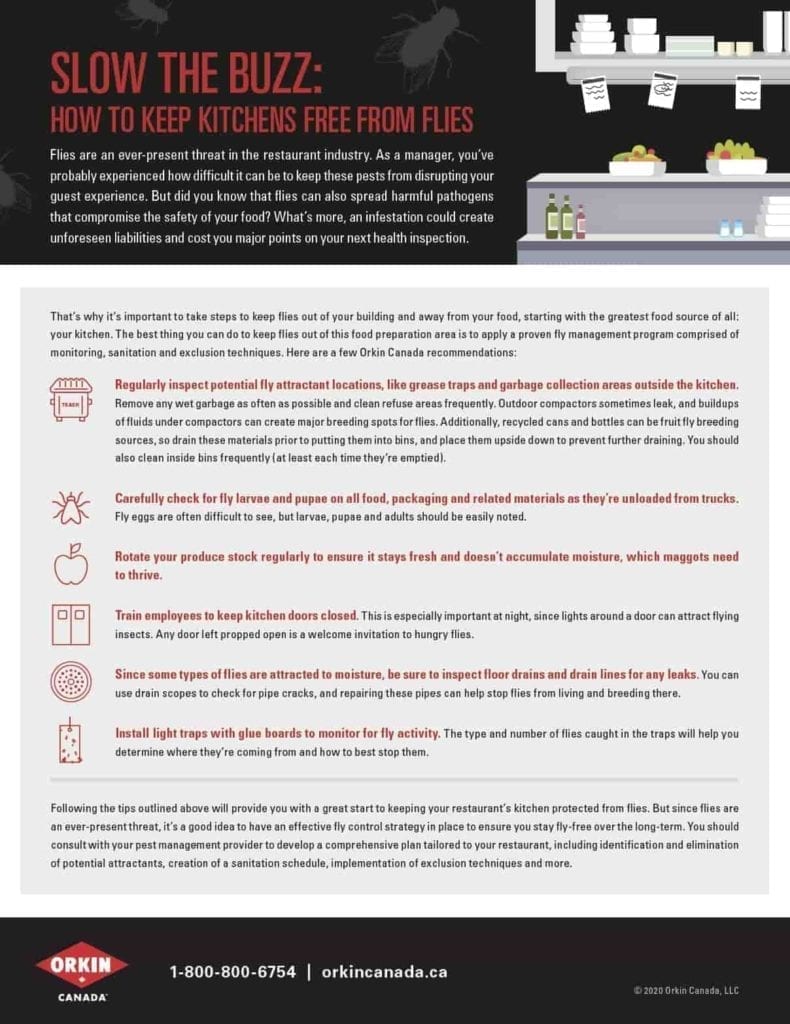Flies are an ever-present threat in the restaurant industry. As a manager, you’ve probably experienced how difficult it can be to keep these pests from disrupting your guest experience. But did you know that flies can also spread harmful pathogens that compromise the safety of your food? What’s more, an infestation could create unforeseen liabilities and cost you major points on your next health inspection.
That’s why it’s important to take steps to keep flies out of your building and away from your food, starting with the greatest food source of all: your kitchen. The best thing you can do to keep flies out of this food preparation area is to apply a proven fly management program comprised of monitoring, sanitation and exclusion techniques. Here are a few Orkin Canada recommendations:
Regularly inspect potential fly attractant locations, like grease traps and garbage collection areas outside the kitchen
Remove any wet garbage as often as possible and clean refuse areas frequently. Outdoor compactors sometimes leak, and buildups of fluids under compactors can create major breeding spots for flies. Additionally, recycled cans and bottles can be fruit fly breeding sources, so drain these materials prior to putting them into bins, and place them upside down to prevent further draining. You should also clean inside bins frequently (at least each time they’re emptied).
Carefully check for fly larvae and pupae on all food, packaging and related materials as they’re unloaded from trucks
Fly eggs are often difficult to see, but larvae, pupae and adults should be easily noted.
Rotate your produce stock regularly to ensure it stays fresh and doesn’t accumulate moisture, which maggots need to thrive
Train employees to keep kitchen doors closed
Training your employees to close kitchen doors is especially important at night, since lights around a door can attract flying insects. Any door left propped open is a welcome invitation to hungry flies.
Since some types of flies are attracted to moisture, be sure to inspect floor drains and drain lines for any leaks
You can use drain scopes to check for pipe cracks, and repairing these pipes can help stop flies from living and breeding there.
Install light traps with glue boards to monitor for fly activity
The type and number of flies caught in the traps will help you determine where they’re coming from and how to best stop them.
Following the tips outlined above will provide you with a great start to keeping your restaurant’s kitchen protected from flies. But since flies are an ever-present threat, it’s a good idea to have an effective fly control strategy in place to ensure you stay fly-free over the long-term. You should consult with your pest management provider to develop a comprehensive plan tailored to your restaurant, including identification and elimination of potential attractants, creation of a sanitation schedule, implementation of exclusion techniques and more.
Need a quick reference guide for all of this? You can also download our expert tips sheet here.
You may also like
Top Pests Expected To Trend In The Summer Of 2023
Warm weather is around the corner, which means pests that have been overwintering or hibernating will wake up as well as non-hibernating pests will start making an appearance outdoors. Being prepared for those spring and summer pests can have an impact on how enjoyable your time will be at home or at work. Using industry leading expertise, we have put together a comprehensive list on the top 8 pests expected to trend in the summer of 2023. This list will provide a deeper dive into the impact that pests can have on your property, along with prevention tips to keep your home or business pest-free.
How To Get Rid Of Flies
With warmer weather around the corner, Orkin Canada is prepared for the pests that come with the warmer weather and melting snow. Everyone is looking forward to flowers blooming, birds chirping, and flies coming in through the open door. Oh wait, not that last one! Flies are a nuisance that no one likes buzzing around inside their home or business. There are many different species of flies; however, they all can cause a threat to your peace of mind, while some are a threat to your health and wellbeing inside your home or business. Whether its cluster flies, house flies, or fruit flies, at Orkin Canada we have 70+ years of expert advice on how to get rid of these unwanted pests. These flies do not stand a chance up against the Orkin Canada technician.
Top 7 Pests Predicted To Trend In 2022
From mosquitoes and wildlife to ticks and flies, being prepared for spring and summer pests can have an impact on how enjoyable your time outdoors will be. Do not worry you are not alone, as the experienced team at Orkin Canada is there to help you prepare. After doing thorough research, we have put together a comprehensive list on the top 7 pests expected to trend in the summer of 2022. This list will provide an in-depth look at the impact that pests will have on your home or business, along with also providing easy to use preventative tips.
5 Tips To Get Rid Of Fruit Flies
To some, fruit flies are probably the most headache inducing pest to deal with. What these flies lack in stinging or biting power, they more than make up for in being a consistent nuisance in your home or business. Using our industry knowledge and expertise, we have put together five easy tips to keep fruit flies out of your kitchen.
Remove pests from your business, and stop them from coming back
We work hard to listen, understand and assess your unique situation. Request a free, no-obligation consultation today for a customized pest program that fits your needs.
Request a Free Business ConsultationRequest a Free Home Estimate


